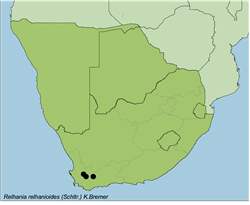Names and synonyms
Relhania relhanioides (Schltr.) Bremer
=Nestlera relhanioides Schltr.
=Nestlera consimilis S. Moore
Type
Schlechter 8849, Cold Bokkeveld, c. 3500 ft., 1896 (Z, BM, BOL, K, L, P, PRE, S, W).
Derivation of names
Relhania = after Irish-born Richard Relhan (1754-1823), botanist, plant collector, bryologist, lichenologist, one of the founders of the Linnean Society, rector in Lincolnshire and author of Flora Cantabile.
relhanoides = resembling the genus Relhania
Diagnostic characters
Capitula solitary or in small clusters, larger than in R. tricephala
Leaves narrow, linear
Villose ray floret cypselas
Description
A moderately branched shrublet, 0.3-0.5 m tall. Stems ascending-erect, tomentose, leafy, becoming glabrous and nude and marked with leaf-scars. Leaves alternate, spreading, sometimes slightly twisted, canaliculate with involute margins, linear or narrowly obovate, 4-13 x 0.5-1.5 mm, glabrous or tomentose dorsally, densely lanate and whitish above, tip rounded. Capitula solitary, sessile, terminal. Involucre cup-shaped, 2.5-6 mm wide. Involucral bracts 25-50, outer ovate, inner gradually longer and oblong-obovate and apically brown as well as scarious, innermost spatulate with a spreading, brownish apical limb, to 6 x 2.3 mm, inner dorsally and basally gland-dotted, obtuse-rounded. Receptacle flat-convex, epaleate, but shortly squamose. Ray florets 15-25, tube 1.4-2 mm long, lamina elliptic, 3.5-4.x 1-1.4 mm, 4-veined. Disc florets 15-35, 9-sterile. Pappus crownlike, of connate scales, up to 1.3 mm long. Cypselas oblong, 1.4-2.3 mm long, glabrous or densely villose.
Flowering time
Mainly from August to October.
Distribution
Occurs around Ceres, Worcester, Touws River and Witteberg.
Known from less than 10 specimens.
Habitat
It grows on sandy, shale or clayey soil on the flats below the mountains.
Notes
This species is closely related to R. corymbosa and R. tricephala, but easily distinguished by the solitary capitula.
References
BREMER, K. 1976. The genus Relhania (Compositae). Opera Botanica 40.
KESTING, D. & CLARKE, H. 2008. Botanical names, what they mean. Wild Flowers of the Cape Peninsula, 3rd revised edition. Friends of Silvermine.
